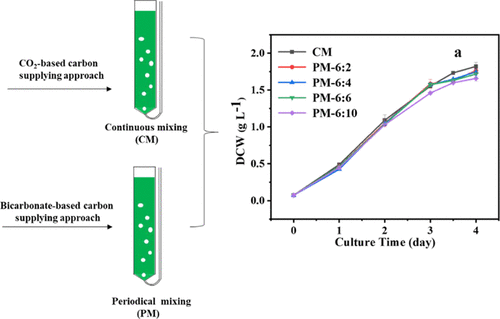当前位置:
X-MOL 学术
›
ACS Sustain. Chem. Eng.
›
论文详情
Our official English website, www.x-mol.net, welcomes your
feedback! (Note: you will need to create a separate account there.)
Cost-Effective and Efficient Production of Carbohydrates from an Alkalihalophilic Leptolyngbya sp. in a Photobioreactor with Periodical Mixing
ACS Sustainable Chemistry & Engineering ( IF 7.1 ) Pub Date : 2020-09-18 , DOI: 10.1021/acssuschemeng.0c05499 Chenba Zhu 1, 2 , Jian Che 3 , Xiaoqian Zhai 1 , Jinghan Wang 1 , Fantao Kong 1 , Zhanyou Chi 1
ACS Sustainable Chemistry & Engineering ( IF 7.1 ) Pub Date : 2020-09-18 , DOI: 10.1021/acssuschemeng.0c05499 Chenba Zhu 1, 2 , Jian Che 3 , Xiaoqian Zhai 1 , Jinghan Wang 1 , Fantao Kong 1 , Zhanyou Chi 1
Affiliation

|
Using sodium bicarbonate (NaHCO3) as the carbon source makes it possible to decouple mixing and carbon supply in microalgae cultivation, and a periodical mixing may be sufficient to support rapid microalgae growth. To test this idea, growth of a screened Leptolyngbya sp. DUT 001 cultured with NaHCO3 was evaluated in a bubbling column photobioreactor. First, the culture medium of this strain was optimized as 25.2 g L–1 NaHCO3 and 0.5 g L–1 NaNO3, in which condition the achieved highest biomass productivity and carbohydrate content were 0.74 g L–1 d–1 and 75.7 ± 1.3%, respectively. Second, the effect of four periodical mixing modes of 6:2, 6:4, 6:6, and 6:10 (bubbling/stopping, s) on microalgae growth was investigated, and these cultures resulted in the highest biomass concentrations of 1.76 ± 0.03, 1.75 ± 0.04, 1.72 ± 0.05, and 1.66 ± 0.04 g L–1, respectively. Correspondingly, the highest carbohydrate contents were 56.5 ± 1.2, 63.0 ± 2.5, 64.7 ± 2.1, and 60.6 ± 2.5%, respectively. However, there was no significant difference between these values and those achieved in the control group with continuous mixing (P > 0.05), which was 1.82 ± 0.06 g L–1 and 59.3 ± 1.3%, respectively. These results showed that it is feasible to use periodical mixing in microalgae cultivation, which may significantly reduce the microalgae biomass production cost.
中文翻译:

从嗜碱性钩端螺旋体sp。节省成本和有效地生产碳水化合物。在定期混合的光生物反应器中
使用碳酸氢钠(NaHCO 3)作为碳源,可以使微藻培养中的混合与碳供应脱钩,并且定期混合可能足以支持微藻的快速生长。为了检验这个想法,筛选出的Leptolyngbya sp。的生长。在鼓泡柱光生物反应器中评估用NaHCO 3培养的DUT 001 。首先,将该菌株的培养基优化为25.2 g L –1 NaHCO 3和0.5 g L –1 NaNO 3,在这种情况下,获得的最高生物量生产力和碳水化合物含量为0.74 g L –1 d –1和75.7±1.3%。其次,研究了4:2、6:4、6:6和6:10的四种周期性混合模式(起泡/停止,s)对微藻生长的影响,这些培养物导致最高生物量浓度为1.76分别为±0.03、1.75±0.04、1.72±0.05和1.66±0.04 g L –1。相应地,最高碳水化合物含量分别为56.5±1.2、63.0±2.5、64.7±2.1和60.6±2.5%。然而,这些值与连续混合的对照组之间没有显着差异(P > 0.05),为1.82±0.06 g L –1和59.3±1.3%。这些结果表明在微藻培养中使用定期混合是可行的,这可以显着降低微藻生物质的生产成本。
更新日期:2020-10-12
中文翻译:

从嗜碱性钩端螺旋体sp。节省成本和有效地生产碳水化合物。在定期混合的光生物反应器中
使用碳酸氢钠(NaHCO 3)作为碳源,可以使微藻培养中的混合与碳供应脱钩,并且定期混合可能足以支持微藻的快速生长。为了检验这个想法,筛选出的Leptolyngbya sp。的生长。在鼓泡柱光生物反应器中评估用NaHCO 3培养的DUT 001 。首先,将该菌株的培养基优化为25.2 g L –1 NaHCO 3和0.5 g L –1 NaNO 3,在这种情况下,获得的最高生物量生产力和碳水化合物含量为0.74 g L –1 d –1和75.7±1.3%。其次,研究了4:2、6:4、6:6和6:10的四种周期性混合模式(起泡/停止,s)对微藻生长的影响,这些培养物导致最高生物量浓度为1.76分别为±0.03、1.75±0.04、1.72±0.05和1.66±0.04 g L –1。相应地,最高碳水化合物含量分别为56.5±1.2、63.0±2.5、64.7±2.1和60.6±2.5%。然而,这些值与连续混合的对照组之间没有显着差异(P > 0.05),为1.82±0.06 g L –1和59.3±1.3%。这些结果表明在微藻培养中使用定期混合是可行的,这可以显着降低微藻生物质的生产成本。











































 京公网安备 11010802027423号
京公网安备 11010802027423号